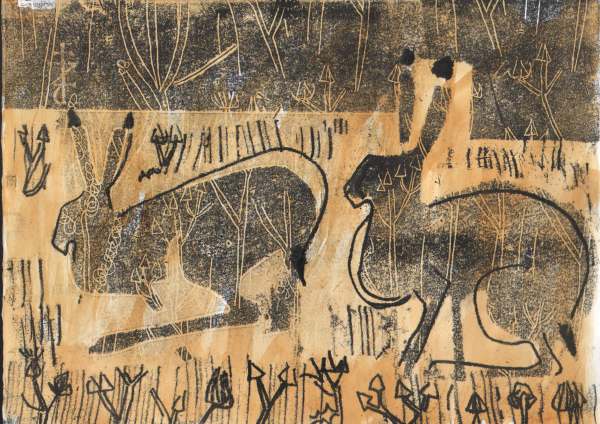
6734 – golden plover, skylarks, lapwing – wallasea island – monoprint – 38 x 27 cms – Probably the most simple way of monoprinting, hinging paper onto a perspex block that is covered with a thin layer of ink. You then draw on the back with a biro or just press with fingers. The area at the bottom is working back into the ink, scraping and then rollering the back of the paper
2nd trip to Wallasea to look at the development of the reserve (see write up from first trip), One of a series of visits by SWLA artists in collaboration with the RSPB.
I used the time to carry on with my outdoor printing experiments. Focusing more on monoprint this time. It seems a bit crazy rolling out ink, perched on a seawall but it does seem worth it. Forced to simplify in diverse ways…Forced to be much more conscious of what happens to the paper surface (the slightest touch on the back of the paper will leave marks). There is a sense of ‘making moves’, how could I make a block of ‘ploughed earth’… and then suddenly you have a whole block of ploughed earth equivalent to push against… By masking bits of the ‘ploughed of earth’ with ripped paper there is a bit of saved space for a skylark or plover.
Final morning spent with golden plover in a freshly ploughed field, a merlin putting them up a couple of times. Flickering gold uppers and shining white bellies, timidly circling. Unsure whether to land on the plough again or head out to the mudflats. Keeping company with wood pigeons, stock doves, lapwing and skylarks.

6741 – hares amongst arable weeds – wallasea island – monoprint – 21 x 29.7cms (A4) – using card incised wtih weed pattern to make tonal blocks, cutting stencils to block all but the hare forms, then drawing on the back of the paper for outlines.
The plant that seemed to predominate was bristly oxtongue, down in the huge fields below the newly raised sea defences some kind of tractor driven mower was gradually clearing swathes of it. Hares robbed of their cover were bounding around, seeming disorientated. I imagine that this was in preparation for ploughing that was already happening to the land off in the distance.
In general the scene was very quiet, few birds. Maybe partly because it will take a while for the new landscape to regenerate, also tides were quite low and so birds could stay down on the coastal margins.
Brin & Richard found a dead young brent goose on the sea wall, seemingly dying from exhaustion. It’s breast bone sharp with no fat either side. Hard to imagine that it had been an egg somewhere in Northern Russia only a few weeks ago.


